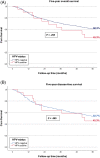The unveiled reality of human papillomavirus as risk factor for oral cavity squamous cell carcinoma
- PMID: 33634865
- PMCID: PMC8251537
- DOI: 10.1002/ijc.33514
The unveiled reality of human papillomavirus as risk factor for oral cavity squamous cell carcinoma
Abstract
The prognostic impact of human papillomavirus (HPV) in oropharyngeal cancer is generally acknowledged, and HPV-status is assessed routinely in clinical practice. Paradoxically, while the oral cavity seems the predilection site for productive HPV-infections, figures on HPV-attribution in oral cavity squamous cell carcinoma (OCSCC) differ widely, and prognostic impact is uncertain. Major obstacles are the lack of reproducible assays to detect HPV in nonoropharyngeal cancers, the relatively small cohorts studied and consequently the shortfall of convincing data. In our study, we used a validated, nucleic acid-based workflow to assess HPV-prevalence in a consecutive cohort of 1016 OCSCCs, and investigated its prognostic impact. In parallel, we analyzed p16-immunohistochemistry (p16-IHC) as surrogate marker for transforming HPV-infection and independent prognosticator. All OCSCC-patients diagnosed between 2008 and 2014 at two Dutch university medical centers were included (N = 1069). Formalin-fixed, paraffin-embedded (FFPE)-samples of 1016 OCSCCs could be retrieved. Punch biopsies were taken from the tumor area in the FFPE-blocks and tested for HPV. P16-IHC was performed on 580 OCSCCs, including all HPV-positive tumors. From 940 samples (92.5%), nucleic acids were of sufficient quality for HPV-testing. In total, 21 (2.2%) OCSCCs were HPV DNA-positive. All HPV DNA-positive tumors were E6 mRNA-positive and considered as true HPV-positive. There was no difference in survival between HPV-positive and HPV-negative OCSCCs. In total, 46 of 580 (7.9%) OCSCCs were p16-immunopositive, including all HPV-positive tumors. Survival was comparable in p16-positive and p16-negative OCSCCs. To conclude, HPV-prevalence is very low in OCSCC and neither HPV-status nor p16-status affects outcome. Based on these data, determining HPV-status in OCSCC seems irrelevant for clinical management.
Keywords: human papillomavirus; oral cavity squamous cell carcinoma; p16-immunohistochemistry; prevalence; prognosis.
© 2021 The Authors. International Journal of Cancer published by John Wiley & Sons Ltd on behalf of Union for International Cancer Control.
Conflict of interest statement
Daniëlle A. M. Heideman has been on the speakers' bureau of QIAGEN and serves occasionally on the scientific advisory boards of Pfizer and Bristol‐Myers Squibb; Daniëlle A.M. Heideman is minority shareholder of Self‐screen B.V., a spin‐off company of VUmc; Self‐screen B.V. holds patents related to the work (ie, high‐risk HPV test and methylation markers). C. René Leemans has been on the advisory boards of Merck & Co. Inc., Rakuten Medical, and Nanobiotix, and reports research grants from KWF Kankerbestrijding/Dutch Cancer Society, VUmc Cancer Center Amsterdam Foundation, GenMab, BMS and the Hanarth Foundation, outside the submitted work. Ruud H. Brakenhoff reports grants from GenMab, InteRNA technologies, and Agilent and nonfinancial support from AbbVie, outside the submitted work. All the other authors declared no potential conflicts of interest.
Figures




Similar articles
-
The prognostic role of sex, race, and human papillomavirus in oropharyngeal and nonoropharyngeal head and neck squamous cell cancer.Cancer. 2017 May 1;123(9):1566-1575. doi: 10.1002/cncr.30353. Epub 2017 Feb 27. Cancer. 2017. PMID: 28241096 Free PMC article.
-
Risk stratification of early stage oral tongue cancers based on HPV status and p16 immunoexpression.Asian Pac J Cancer Prev. 2014;15(19):8351-9. doi: 10.7314/apjcp.2014.15.19.8351. Asian Pac J Cancer Prev. 2014. PMID: 25339028
-
Molecular characterization of p16-immunopositive but HPV DNA-negative oropharyngeal carcinomas.Int J Cancer. 2014 May 15;134(10):2366-72. doi: 10.1002/ijc.28580. Epub 2013 Nov 19. Int J Cancer. 2014. PMID: 24249631
-
HPV DNA, E6/E7 mRNA, and p16INK4a detection in head and neck cancers: a systematic review and meta-analysis.Lancet Oncol. 2014 Nov;15(12):1319-31. doi: 10.1016/S1470-2045(14)70471-1. Epub 2014 Oct 16. Lancet Oncol. 2014. PMID: 25439690
-
Roles of Human Papillomaviruses and p16 in Oral Cancer.Asian Pac J Cancer Prev. 2015;16(15):6193-200. doi: 10.7314/apjcp.2015.16.15.6193. Asian Pac J Cancer Prev. 2015. PMID: 26434816 Review.
Cited by
-
Tissue microarray analyses of the essential DNA repair factors ATM, DNA-PKcs and Ku80 in head and neck squamous cell carcinoma.Radiat Oncol. 2024 Oct 30;19(1):150. doi: 10.1186/s13014-024-02541-3. Radiat Oncol. 2024. PMID: 39478631 Free PMC article.
-
Immune landscape and subtypes in primary resectable oral squamous cell carcinoma: prognostic significance and predictive of therapeutic response.J Immunother Cancer. 2021 Jun;9(6):e002434. doi: 10.1136/jitc-2021-002434. J Immunother Cancer. 2021. PMID: 34130988 Free PMC article.
-
Prognostic Relationship Between Human Papillomavirus Status and Overall Survival in Patients with Tongue Cancer.Viruses. 2025 May 29;17(6):780. doi: 10.3390/v17060780. Viruses. 2025. PMID: 40573372 Free PMC article.
-
Disparities in head and neck cancer incidence and trends by race/ethnicity and sex.Head Neck. 2023 Jan;45(1):75-84. doi: 10.1002/hed.27209. Epub 2022 Oct 6. Head Neck. 2023. PMID: 36200577 Free PMC article.
-
Oral Cavity Squamous Cell Carcinoma: An Update of the Pharmacological Treatment.Biomedicines. 2023 Apr 7;11(4):1112. doi: 10.3390/biomedicines11041112. Biomedicines. 2023. PMID: 37189730 Free PMC article. Review.
References
-
- Castellsague X, Alemany L, Quer M, et al. HPV involvement in head and neck cancers: comprehensive assessment of biomarkers in 3680 patients. J Natl Cancer Inst. 2016;108(6):djv403. - PubMed
-
- Ndiaye C, Mena M, Alemany L, et al. HPV DNA, E6/E7 mRNA, and p16INK4a detection in head and neck cancers: a systematic review and meta‐analysis. Lancet Oncol. 2014;15(12):1319‐1331. - PubMed
-
- Woods RSR, Keegan H, White C, et al. Cytokeratin 7 in oropharyngeal squamous cell carcinoma: a Junctional biomarker for human papillomavirus‐related tumors. Cancer Epidemiol Biomarkers Prev. 2017;26(5):702‐710. - PubMed
Publication types
MeSH terms
Substances
Grants and funding
LinkOut - more resources
Full Text Sources
Other Literature Sources
Medical
Miscellaneous

